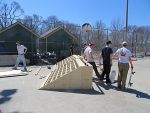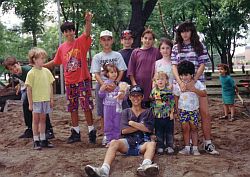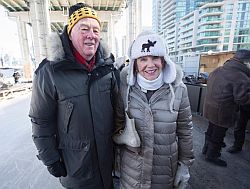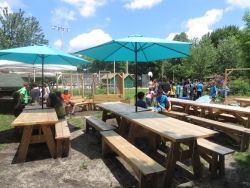Comments?
For the basics, see
- Website & Privacy Policies
- How To Get Involved
- The Role of the Park
Search options:
Department Site Map
Custodians:
Newsletter June 2018
 Jane Jacobs |
This newsletter is put out by CELOS, the Centre for Local Research into Public Space. Since 2000, when this little organization began at Dufferin Grove Park, we’ve been doing what we call “theoretical and practical research” into what makes public spaces – like parks – more hospitable and more lively. We’ve been researching what works and what doesn’t, and we’ve documented a lot of what we’ve seen and done, in this newsletter and on our five websites.
The DIY skateboard park
In 2007, the skateboard-park equipment that was at Scadding Rink had to be moved because that rink was being rebuilt. So it all came over to the Dufferin Grove pleasure-skating pad for the summer, and so did the skateboarders. A year or two later, when Scadding Rink was finished, the equipment was moved back, but a few older pieces were left here. Some of the skateboarders stayed too, and slowly, with the help of Rob Poyner (who had built some of the best Scadding equipment) they began to add more equipment here at Dufferin rink pad, one piece at a time. Skater Jason Kun decided he liked the atmosphere better at Dufferin Grove, so he and a few friends began looking after the equipment, and more skaters started coming. The recreation staff made them welcome and helped with equipment storage in the off-season.

a new piece
As the years went on, local youth started saying that the skateboard pad was their home away from home. It became a place for forming friendships.
Jason Kun got busy with his oyster-shucking business and his growing family, so others stepped up. Tom Berry, who lived in the neighbourhood, started helping with equipment maintenance. In 2015, the Converse company donated a piece. Then in 2016, the GH Wood Foundation donated $1000 (through CELOS) for materials, such as high-quality plywood that could stand the constant usage. When those funds were spent, Tom Berry figured out how to raise funds with crowd-funding, first through Kickstarter (about $1000) and then through GoFundMe, which is cheaper to use. This year they raised $3000.
Tom says that in each of the last few years, round about February, a few of the older skateboarders put their heads together to plan what might be an interesting, challenging new structure. Then on a warm weekend in April, Tom and his friends Ryan Wilding, Zack McRae, and Andrew McEwan bring over the lumber and the tools. They set up on the rink pad, fixing the older equipment and then building one or two pieces new. All except Tom work as contractors or carpenters in their day jobs. Younger people who want to learn can watch or help out, or practice their stunts around the periphery. (Occasionally even some girls come.)
And little kids stand at the fence, watching, maybe dreaming of the time when they’ll be ready to start defying gravity too.
A mystery: the “northwest corner revitalization” project
In late October of 2016, City Councillor Ana Bailao invited people to a community meeting about improving the corner of Dufferin Grove Park, including the rink clubhouse, the ovens, and the gardens. To run the meeting, the city hired LURA, a company specializing “in both market-based solutions and community-based behaviour change mechanisms.”
At the meeting, the city’s capital-projects staff said that nothing was set in stone – the clubhouse building could stay the same, or be renovated, or be taken down and built new. They said no funds had been put in the budget yet. After the meeting a call was put out for park users to apply for membership in a “Community Resource Group” (CRG) that would follow up with the details. Ten people volunteered, and all were accepted.
The city set up an information website (dufferingrove-northwestrevitalization.ca), and – urged by the CRG members – released some more information, including a “Field House Kitchen Feasibility Study” that the city had commissioned from another consultant back in 2015, and a “draft scope of work” that included the possibility of replacing the current pleasure-skating rink pad/DIY skateboard park with a skating trail.
In the end, the CRG group only met twice, in early 2017, and came to no agreement. Two of its members joined a city staff “Request for Proposals” (RFP) panel to evaluate the bids for a consulting company to plan the details of the work, still not clearly defined. Then there was a long silence until a park friend, Migs Bartula, came across some Dufferin Grove budget lines in the Parks Capital Budget: $694,747 for “Professional and Technical Design Consulting Services for a New Community Recreation Clubhouse, and Park Improvements at North-West Corner of Dufferin Grove Park” between 2018 and 2021, plus $3.14 million for "the Dufferin Grove New Community Centre” (that is, the rink clubhouse). Plus another $253,000 “to cover the cost of provision of design in 2018.”
The mystery is that the rink house is only twenty-five years old, a solid building that could be made serviceable with some pretty straightforward (and much less costly) fixes. Beyond that, although the city’s program costs have risen every year, the program itself is faltering (see p.5). It’s a puzzle: who decided to tear down the building, the ovens, the gardens, and replace them all, and why?
More details are posted here, and we’ll add new material as we find out more.
The park trees
Dufferin Grove Park got its name from its trees. There’s lots of shade, including at the playground, whereas many playgrounds elsewhere in the city are sun-baked all summer long.

May 2018: uprooted
The shade has been is getting a little less, because of a late-winter ice storm and an early-spring windstorm, during which some giant trees were actually uprooted. But the newer trees that were planted in the past 15 years are getting taller, and starting to make some significant shade already.
A bit of tree history: the city’s parks, including Dufferin Grove, had a big addition of new trees in 2007, but that turned out to be a drought year. Many of the city’s new trees died of thirst – but not in this park. That was the year park friend Michael Monastyrskyj asked if the park needed any volunteer help. He and the recreation staff set up hoses at water outlets all over the park, and Michael spend the drought months dragging the hoses from tree to tree. Not a single new tree was lost. Michael began paid work at the park at the end of that summer.
In early May, CELOS asked landscaper/artist Gene Threndyle to walk around the park and have a look at the trees (some of which he had helped us to plant over the years). The photos of this walk, accompanied by Gene’s comments are posted at dufferinpark.ca in the “gardens” section here.
On Friday June 8 at 6.30 pm, part-time park program staff Leslie Lindsay and Anna Bekerman (who both worked with the garden club to plant and take care of some of the tree gardens over the years) will finish the inventory. Tree friends who would like to do the tree walk with them are welcome: meet at the Friday Night Supper site.
DOLA (Dog Off-Leash Area) coming to Dufferin Grove:
Back in November 2017, Councillor Bailao called a meeting to talk about the city’s proposed off-leash dog area, to be installed down in the former Garrison Creek bed along the western edge of Dufferin Grove. The Parks capital projects budget for 2018 lists $40,000 for a consultant to plan the dog park and $260,000 to instal it.
It seems that dog parks in other parts of Toronto have been getting mixed reviews. A new one at Raymore Park in Etobicoke looks a bit like a prison exercise yard. Dog parks with the Toronto standard of pea gravel surfacing seem to be particularly contentious, since the gravel can get stuck in the dogs’ paws.
Eric Code, who is part of a group called Leash Free Toronto, and a goldmine of dog park information, writes: "The idea isn't just to create parks for dogs - it's to create conditions that make it easier for people and dogs to share public space in harmony. The more crowded cities get, the more important this becomes."
Eric says that recently, Toronto’s “one-size-fits-all” approach seems to be getting more flexible. His very helpful annotated links are listed in the “dogs” section of the dufferinpark.ca website here. He recommends, for instance, "Unleashed: A Guide to Successful Dog Parks," commissioned by the Government of South Australia, saying “they have some of the best dog parks in the world, since so many people have dogs (2/3 of households).” – Who knew?
How to cool down on hot days
Up until about ten years ago, staff used to open the wading pool during pre-summer heat waves: fun, and relief from the heat for families. Then all city wading pools changed to being run centrally, one-size-fits-all, and they all opened only for the school holidays. But when the Dufferin Grove pool was renovated in 2009, sprinklers were added to make a kind of splash pad for hot days before the summer officially began.
The sprinklers can’t really be used that way, though, because the new surfacing that was applied to the pool turned out to be really slippery. When the sprinklers are turned on or even when the drinking fountain leaks water, the pool coating becomes so slippery that staff need to be there in case of injuries.
Since the surface coating is also peeling in many places, the Parks manager said in 2016 that it would be removed and the wading pool would revert to its original concrete surface (installed in 1954, thick enough to last 500 years). However, as of May 2018, that has not happened. So no cooling sprinklers during the hot spell in May, and probably not in June either.
That’s the bad news. The good news is that the park has the watertap in the sandpit/adventure playground, so the kids (and some of their playful parents) can still get muddy and cool that way.
The sandpit/adventure playground

sandpit founders,1993
The sandpit was put into the park in 1993, with a $5000 donation from the Dufferin Mall. Then-mayor June Rowlands came to open it officially, and City TV was there with its remote news truck. At first it measured 20 x 40 feet, but over the years it became so well-used that the kids expanded it until it takes up the whole corner of the playground area. Part of the Dufferin Mall donation was used to hire some artists to do projects with the kids, headed up by Elyse Pomeranz (later a Waldorf teacher). Her husband Amnon Buchbinder, who later became the dean of the film program at York University, was hired by the Parks Department to make a 10-minute film about it. The film, called “The Big Backyard,” is posted on the home page of the dufferinpark.ca website. It shows a playground full of fun activities but no water tap – that didn’t come until later, after several years of lobbying by the kids who played there.
Last August, City Council’s Parks Committee discussed a Parks staff report about putting in a few more such playgrounds into other parks. That would take the pressure off Dufferin Grove, since the adventure playground here can get so crowded with visiting classes and day camps, from all over the city and beyond, that it’s not fun anymore.
The city staff who made the report didn’t talk to CELOS, but they did lay down some requirements for risk assessments, inspection protocols, extra staffing, and water access. We’re happy to share our experience, and this may be the right time to start the conversation.
The numbers are in: how much does it cost to operate Dufferin Grove Park?
With the help of quite a few reports that we got through Freedom of Information, CELOS has made what we think is a pretty accurate estimate of how much it currently costs to run the park: $1.3 million a year.
That’s a surprise. Costs have gone up steeply in the past few years. Using the city’s SAP accounting spreadsheets, we found out that
- Recreation program staffing in 2017 cost $587,715
- Parks maintenance staffing in 2017 cost $540,855 (a careful estimate, since the maintenance costs are not specified for exact location)
- subtract $123,544 income from food and skate lending, plus another $7002 income for rink permits
- add $300,000 (conservative estimate) for costs missing from the Ward 18 SAP reports: work by Forestry, Solid Waste (park garbage collection in trucks), centralized data entry, centralized food ordering, and management costs for the Parks supervisor and Forestry supervisor time allocated to Dufferin Grove Park.
Dufferin Grove food income has gone down steadily over the past four years, to the point where it covers less than the cost of materials and none of the wages for the cooks and servers. In other words, park food, which used to make enough extra money to support other park programs, is now subsidized by the city.
Remarkably, $1.3 million doesn’t cover a lot of basic things:
- park washrooms are not reliably open on statutory holidays
- the sandpit water outlet works poorly
- the staffing of the adventure playground is hit or miss
- there’s unreliable staffing for busy times in spring and fall, outside of rink season or school holidays
- repairs to plumbing, to both playgrounds, to the wading pool, to the rink house are erratic
- café hours are not scheduled by park usage, instead there is set-in-stone staff scheduling
- wading pool schedules are not fitted to weather (heat waves, cold days)…
…and that’s just the tip of the iceberg. Happily, this may be the right year to start fixing these troubles.
A new interest in community-government partnerships at City Hall?
In January 2018, the general manager of Parks, Forestry and Recreation, Ms. Janie Romoff, gave a speech at the annual Park People "Parks Summit." She talked about her division’s interest in “collaborative governance relationships” with community non-profits (sometimes called “conservancies”). She said “The City of Toronto does not have a one-conservancy-fits-all model. Instead it develops tailored responses to the specific strengths, skills and interests of its partners.”
As examples, the general manager listed Edwards Gardens, Allan Gardens, Grange Park, and The Bentway. The city commissioned master plans for some of those, so we looked them up. We read that the non-profit Toronto Botanical Garden is interested in taking on the governance of the whole of Edwards Gardens. The city “is prepared to transfer operating funds to the non-profit,” says Richard Ubbens, the city’s Parks Director., because if the non-profit “looks after the entire envelope….a lot more opportunity will be realized." (The "opportunity" that may have got the city excited is the $50 million that the Toronto Botanical Gardens non-profit organization plans to fundraise). And The Bentway was started with a $25 million donation from Judy and Wilmot Matthews, although that amount has already been doubled through the city’s own capital budget.

Judy and Wilmot Matthews, at The Bentway
But does the city only work with non-profits if they’re backed by millions of private donations? Hopefully not. Our guide here is Jane Jacobs. She thought that what she called the “vital little plans” of ordinary people are often better than multi-year plans or global consultants’ plans: “....The more that cities can make of their own ordinary people’s capacities for economic and social invention and experiment, the more useful and valuable cities become – not only for their own people but also for their nations.” And she proposed that local government pay for these experiments with local service contracts. (This comes from Vital Little Plans, an inspired collection of Jane Jacobs' writings and talks, edited by Samuel Zipp and Nate Storring and published in 2016.)
This summer CELOS wants to find out if the groundwork laid by the big players can benefit neighbourhood parks that don’t have millions in donor funds, but that do have tax-based budgets and bake ovens. Can the principles that worked out for the Bentway and Edwards Gardens help our neighbourhood to come back to our former “vital little plan” (which Jane Jacobs said she really liked)? -- For 15 years, while Dufferin Grove staff worked with park friends to make the park more friendly and lively, Parks management insisted that this was not a pilot that could be built on. In 2012 they stepped in to “harmonize” the way the park works with the rest of the city. After six years of this harmonization, the park has rising costs and diminishing service.
But thanks to the heavy lifting being done by the big players, this may be the moment for fixing the trouble in vital little ways as well. Find out more here.
Dan’s Table: the picnic area beside the bigger bake-oven
The seating area beside the bigger bake oven is called “Dan’s Table.” In 2016, CELOS was approached by John Broley of the GH Wood Foundation, which was winding down its affairs. Mr.Broley asked us if we had any ideas for using their last $50,000. We did. Making a sitting area near the bake oven was at the top of our wish list, for the pizza days, suppers, school visits, and community gatherings that have been going on there for 25 years.

"Dan's Table"
Actually, we had been asking the parks manager about making a patio sitting area by the oven for years. The answer was always “no money.” But in April of 2016, with $22,000 of the GH Wood funds there, CELOS hired a good carpenter, Mike Conway, to build the tables, benches, and flower boxes, and in May we brought everything over and installed it. The tables seemed to fill up with people almost instantly. We planted flowers and vegetables in the planters that surround the tables. And for shade, we bought some patio umbrellas from Rona’s.
Why “Dan’s Table”? Because Dan DeMatteis was a beloved chef who got his start at Dufferin Grove, cooking suppers in the bake oven. He died young, in 2012, but now people gather in the area where his name lives on.
The parks staff seem to sometimes regard this sitting area as more of a hassle than a gift. Litter accumulates, weeds grow up, and the shade umbrellas are broken or forgotten in the storage shed. However, supervisor Keith Storey says that broken umbrellas will soon be replaced and the staff will take better care of them. The main thing is setting them up when the sun beats down. Picnickers, you can remind the staff if they forget. And if you see the ubiquitous burdock weeds popping up beside your bench, reach down and yank them out, so they don’t upstage the pretty nasturtiums, morning glories, sweet peas, snow peas, and pole beans that are just starting their climb up the netting.
The Dufferin Grove Farmers’ market: every Thursday from 3 to 7, by the clubhouse.
This market began in 2002. It was only the second park-based market in Toronto (the first one was at Riverdale Farm), and was well-attended from the first day. Market manager Anne Freeman sends out a weekly “market news” email on Wednesdays, with lots of information about what’s in season. A note of caution: at the market, so many people run into their friends, including some long-lost ones, that it takes longer to shop than if a person just goes to a supermarket. The way some people handle this problem is to just buy some supper from one of the many prepared-foods market vendors and have a catch-up with their neighbours under the sun umbrellas at “Dan’s Table” beside the bake-oven. The time they lose by stopping for a conversation is balanced by the time they gain by not having to cook that night. Slow food….




 Printer friendly version
Printer friendly version
